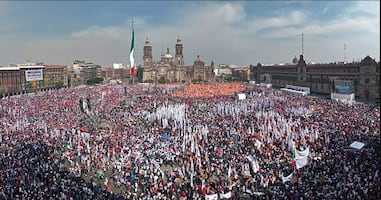Más Información

Por más campañas y alianzas en el extranjero, "no vencerán al pueblo de México ni a su Presidenta": Sheinbaum; celebra "7 Años de Transformación"

Luisa María Alcalde, "Andy" López Beltrán y coordinadores de Morena, permanecen cerca de Sheinbaum en el Zócalo

Mónica Fernández, directora del INDEP, responde a supuesto fraude en triunfo de Fátima Bosch en Miss Universo; "son vaciladas", dice

Científicos ganadores del Nobel subrayan la importancia de financiar la ciencia básica para futuros avances médicos

Cae "El Danone" en Cancún; está identificado como pieza central del CJNG en la zona norte de Quintana Roo
Malinche
, also known as Malintzin or Mrs. Marina , has been disdained throughout history. Nevertheless, the public will see a different side of the story thanks to a new documentary produced by Margarita Flores and directed by Fernando González-Sitges .
The producer explains that “the project came up because of the 500 years since Cortés arrived into what is now Mexico . The intention is to reconcile the story of Malintzin , for that, we had to investigate the biography of this woman and analyze how did things happened because it's very hard when you question a character that isn't from your time. Her world was one in which women were taken as objects.”
Some studies suggest Hernán Cortés and Malintzin met on March 6, 1519 , but we lack concrete information to back this claim, explained Berenice Alcántara , a researcher from the UNAM's Historical Investigations Institute , who was part of the experts who collaborated in the making of the documentary . The other researchers were Camila Townsend from Rutgers University; Luis Barjau from the INAH ; Izaskun Álvarez , from the Salamanca University ; writer Margo Glantz ; historian Federico Navarrete , and Bernard Grunberg, from Reims University . The research lasted over 18 months.
Berenice Alcántara
, a doctor in Mesoamerican studies by the Philosophy and Letters Faculty, UNAM , defines Malintzin as a controversial historical figu re, although it wasn't always like that. It was after the Independence, a negative vision was built around anything linked to the Spanish and at the same time, a negative image of her was constructed as well.
“In the 19th century, La Malinche was seen as a character that had betrayed her people and her nation , that she has been the cause, somehow, of the conquest ; nevertheless, in the 16th and 17th centuries , she was seen as an essential figure for the construction of the new kingdom and was seen as a fundamental part for the Indigenous communities ,” explains the researcher.
In the documentary, they will show the two discourses surrounding Malinche , as the Spanish sources from the time said she has a “sparing” role, while the Indigenous sources claimed she had a key role.
“In the Indigenous sources , even, Malinche has an even more important role than Cortés . The (negative) view of Malinche has prevailed in the last 200 years because of the education given to Mexican people and that has reproduced the nationalism that was built, where the figure of Mrs. Marina is vilified and described as a traitor because she collaborated with the Spanish ,” this is the view that predominates and “the majority of the population doesn't read contemporary historical studies that show other views,” the expert explained.
Among the documents consulted by the experts are the Florentine Codex , where the Tlatelolcas depicted their view on the conquest , as well as the History of Tlaxcala codex.
“ Malintzin. The story of an enigma ” tries to show that the sources allow learning what was the role of Mrs. Marina and how the Indigenous communities saw her and some Spanish, who did highlight her importance, such as Bernal Díaz del Castillo . Everyone has an implicit understanding of her, the majority of people already has a series of prejudices against her, it's difficult to try to show what the historical sources show,” emphasizes Berenice Alcántara.
The experts say that the first thing they did was make it clear that the meeting between I ndigenous people and the Spanish was different from what Mexicans have been told. Then they researched about Malintzin , who was a translator and interpreter , which allowed her to participate in negotiations, she also contributed so that communities such as Tlaxcala had a privileged place.
The expert explains that according to several studies, Malinche possessed knowledge , which “makes it clear that in her childhood, she was a g irl that belonged to the noble strata of the Indigenous societies because she possessed a series of codexes in regards to the use of language that she had as an adult. If she hadn't learned them, she would have hardly been able to interact with Indigenous nobility, leaders, and warriors with whom the Spanish had to communicate with after their arrival.”
Nevertheless, Alcántara emphasizes that until now, it is unknown why was she sold as a “worker” or “ slave ” to merchants from Veracruz and then was bought by Mayans from Tabasco , although it is thought that she did carry out the same activities as other Indigenous women : cook, make tortillas, or textiles.
The documentary mixes investigations and fiction.
Priscila Lepe
plays Malinche ; Fernando de Retes as Hernán Cortés ; Leonardo Alonso , as Moctezuma , and Rubén Salaza r, as Gerónimo de Aguilar.
To play Malintzin, actress Priscila Lepe says had to practice Náhuatl , and read about contemporary investigations and books: “Representing Malinche allows to learn about her strength and everything she had to learn to be in a man's world , she also had the right tools to survive during that time.”
Malintzin
will be released today at 7 p.m. at Cinépolis Plaza Carso and will be available through Claro video on March 7.
gm
Noticias según tus intereses
[Publicidad]
[Publicidad]










